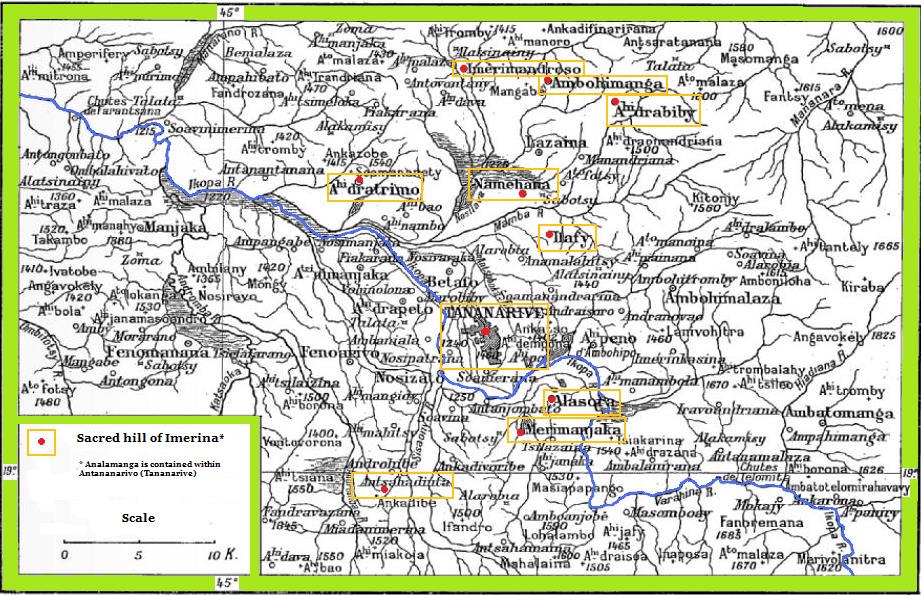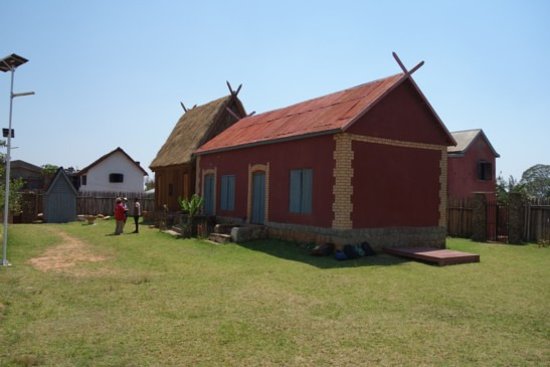|
Twelve Sacred Hills Of Imerina
The twelve sacred hills of Imerina are hills of historical significance to the Merina people of Madagascar. Located throughout Imerina, the central area of the highlands of Madagascar, the sites were often ancient capitals, the birthplaces of key public figures, or the tomb sites of esteemed political or spiritual leaders. The first set of sacred sites was designated by early 17th-century king Andrianjaka. The notion was re-sanctified under late 18th-century king Andrianampoinimerina, who replaced several of the earlier sites with new ones. More than 12 sites were thus designated as sacred over time, although the notion of twelve sacred hills was perpetuated because of the significance of the number 12 in Malagasy cosmology. Today, little concrete evidence of the former importance of many of these sites remains, but the significant archeological and cultural heritage of several of the sites has been preserved. The historic significance of the sites is best represented by the Rova ... [...More Info...] [...Related Items...] OR: [Wikipedia] [Google] [Baidu] |
Alasora
Alasora is a rural commune in Analamanga Region, in the Central Highlands of Madagascar. It belongs to the district of Antananarivo Avaradrano. It is located in the east of Antananarivo. The sacred Hill of Alasora is situated in this municipality. Economy Most important economic factor is agriculture. Alasora is also known to be a place where pottery and earthenware Earthenware is glazed or unglazed Vitrification#Ceramics, nonvitreous pottery that has normally been fired below . Basic earthenware, often called terracotta, absorbs liquids such as water. However, earthenware can be made impervious to liquids ... is made. References External links Populated places in Analamanga {{Analamanga-geo-stub ... [...More Info...] [...Related Items...] OR: [Wikipedia] [Google] [Baidu] |
Vazimba
The Vazimba (Malagasy ), according to popular belief, were the first inhabitants of Madagascar. While beliefs about the physical appearance of the Vazimba reflect regional variation, they are generally described as smaller in stature than the average person, leading some scientists to speculate that they may have been a pygmy people (and therefore a separate ethnic groups of Madagascar, Malagasy ethnic group) who migrated from the islands that constitute modern-day Indonesia and settled in Madagascar over the course of the period between 350 BCE–500 CE. Scientific evidence confirms the first arrival and subsequent increase of human settlers on the island during this period, but the pygmy theory has not been proven. Stories about the Vazimba form a significant element in the cultural history and collective identity of the Malagasy people, ranging from the historical to the supernatural, inspiring diverse beliefs and practices across the island. They have analogs in some other ... [...More Info...] [...Related Items...] OR: [Wikipedia] [Google] [Baidu] |
Samuel Pasfield Oliver
Samuel Pasfield Oliver (1838–1907) was an English artillery officer, geographer and antiquary. Life Born at Bovinger, Essex, on 30 October 1838, he was the eldest and only surviving son of William Macjanley Oliver, rector of Bovinger, by his wife Jane Weldon. He entered Eton College in 1853; and after passing through the Royal Military Academy, Woolwich, he received a commission in the Royal Artillery on 1 April 1859. In the following year he went out with his battery to China, where hostilities had been renewed. The First Convention of Beijing was however signed soon after Oliver's arrival (24 October 1860), and his service was confined to garrison duty at Canton. On the establishment of a British embassy at Beijing in 1861 he accompanied General Sir John Michel on a visit to the capital, and subsequently made a tour through Japan. In the following year he was transferred to Mauritius; and from there with Major-general Johnstone on a mission to Madagascar to congratulate ... [...More Info...] [...Related Items...] OR: [Wikipedia] [Google] [Baidu] |
Solofo Randrianja
Solofo Randrianja is a Malagasy scholar and historian of Madagascar. He is currently a professor at University of Toamasina and, with Stephen Ellis, wrote ''Madagascar: A Short History'', a foundational reference work for the field. Life Education and early career Randrianja was raised in Madagascar, where his father was a political organizer. Randrianja earned a Ph.D. and habilitation from the Denis Diderot University of Paris VII. During political unrest in Madagascar, Randrianja was a potential target due to his advocacy of democracy. He and his family fled to Chicago. Later career With Stephen Ellis, Randrianja wrote ''Madagascar: A Short History'', considered by the Africanist academic community to be a critical reference work in Malagasy history. In fact, the only prior history of Madagascar written in English was published in 1995 by British diplomat Mervyn Brown. During this time, he was also awarded a fellowship at the African Studies Centre Leiden. Following ... [...More Info...] [...Related Items...] OR: [Wikipedia] [Google] [Baidu] |
View Of Ambohimanga Sacred Hill Madagascar
Acornsoft was the software arm of Acorn Computers, and a major publisher of software for the BBC Micro and Acorn Electron. As well as games, it also produced a large number of educational titles, extra computer languages and business and utility packages – these included word processor ''VIEW'' and the spreadsheet '' ViewSheet'' supplied on ROM and cartridge for the BBC Micro/Acorn Electron and included as standard in the BBC Master and Acorn Business Computer. History Acornsoft was formed in late 1980 by Acorn Computers directors Hermann Hauser and Chris Curry, and David Johnson-Davies, author of the first game for a UK personal computer and of the official Acorn Atom manual "Atomic Theory and Practice". David Johnson-Davies was managing director and in early 1981 was joined by Tim Dobson, Programmer and Chris Jordan, Publications Editor. While some of their games were clones or remakes of popular arcade games (e.g. ''Hopper'' is a clone of Sega's ''Frogger'', '' Snapper ... [...More Info...] [...Related Items...] OR: [Wikipedia] [Google] [Baidu] |
Radama I
Radama I "the Great" (c. 1793–1828) was the first Malagasy sovereign to be recognized as King of Madagascar (1810–1828) by a European state, Great Britain. He came to power at the age of 17 following the death of his father, King Andrianampoinimerina. Under Radama's rule and at his invitation, the first Europeans entered his central highland Kingdom of Imerina and its capital at Antananarivo. Radama encouraged these London Missionary Society envoys to establish schools to teach tradecraft and literacy to nobles and potential military and civil service recruits. They also introduced Christianity and taught literacy using the translated Bible. A wide range of political and social reforms were enacted under Radama's rule, including an end to the international slave trade, although this had historically been a key source of wealth and armaments for the Merina monarchy. Through aggressive military campaigns he successfully united two-thirds of the island under his rule. Abuse ... [...More Info...] [...Related Items...] OR: [Wikipedia] [Google] [Baidu] |
Ambohidratrimo
Ambohidratrimo is a municipality in Analamanga Region, in the Central Highlands of Madagascar, located at 15 km from the capital of Antananarivo. There are found the Twelve sacred hills of Imerina The twelve sacred hills of Imerina are hills of historical significance to the Merina people of Madagascar. Located throughout Imerina, the central area of the highlands of Madagascar, the sites were often ancient capitals, the birthplaces of key .... References External links * Populated places in Analamanga {{Analamanga-geo-stub ... [...More Info...] [...Related Items...] OR: [Wikipedia] [Google] [Baidu] |
Vazimba
The Vazimba (Malagasy ), according to popular belief, were the first inhabitants of Madagascar. While beliefs about the physical appearance of the Vazimba reflect regional variation, they are generally described as smaller in stature than the average person, leading some scientists to speculate that they may have been a pygmy people (and therefore a separate ethnic groups of Madagascar, Malagasy ethnic group) who migrated from the islands that constitute modern-day Indonesia and settled in Madagascar over the course of the period between 350 BCE–500 CE. Scientific evidence confirms the first arrival and subsequent increase of human settlers on the island during this period, but the pygmy theory has not been proven. Stories about the Vazimba form a significant element in the cultural history and collective identity of the Malagasy people, ranging from the historical to the supernatural, inspiring diverse beliefs and practices across the island. They have analogs in some other ... [...More Info...] [...Related Items...] OR: [Wikipedia] [Google] [Baidu] |
Ralambo
Ralambo was the ruler of the Kingdom of Imerina in the central Highlands region of Madagascar from 1575 to 1612. Ruling from Ambohidrabiby, Ralambo expanded the realm of his father, Andriamanelo, and was the first to assign the name of Imerina to the region. Oral history has preserved numerous legends about this king, including several dramatic military victories, contributing to his heroic and near-mythical status among the kings of ancient Imerina. The circumstances surrounding his birth, which occurred on the highly auspicious date of the first of the year, are said to be supernatural in nature and further add to the mystique of this sovereign. Oral history attributes numerous significant and lasting political and cultural innovations to King Ralambo. He is credited with popularizing the consumption of beef in the Kingdom of Imerina and celebrating this discovery with the establishment of the '' fandroana'' New Year's festival which traditionally took place on the day of Ral ... [...More Info...] [...Related Items...] OR: [Wikipedia] [Google] [Baidu] |
Tomb Of Ralambo In Ambohitrabiby Madagascar
A tomb ( ''tumbos'') or sepulchre () is a :wikt:repository, repository for the remains of the dead. It is generally any structurally enclosed interment space or burial chamber, of varying sizes. Placing a corpse into a tomb can be called ''immurement'', although this word mainly means entombing people alive, and is a method of Disposal of human corpses, final disposition, as an alternative to cremation or burial. Overview The word is used in a broad sense to encompass a number of such types of places of interment or, occasionally, grave (burial), burial, including: * Shrine, Architectural shrines – in Christianity, an architectural shrine above a saint's first grave (burial), place of burial, as opposed to a similar shrine on which stands a reliquary or feretory into which the saint's remains have been transferred * Burial vault (tomb), Burial vault – a stone or brick-lined underground space for multiple burials, originally vault (architecture), vaulted, often priva ... [...More Info...] [...Related Items...] OR: [Wikipedia] [Google] [Baidu] |




